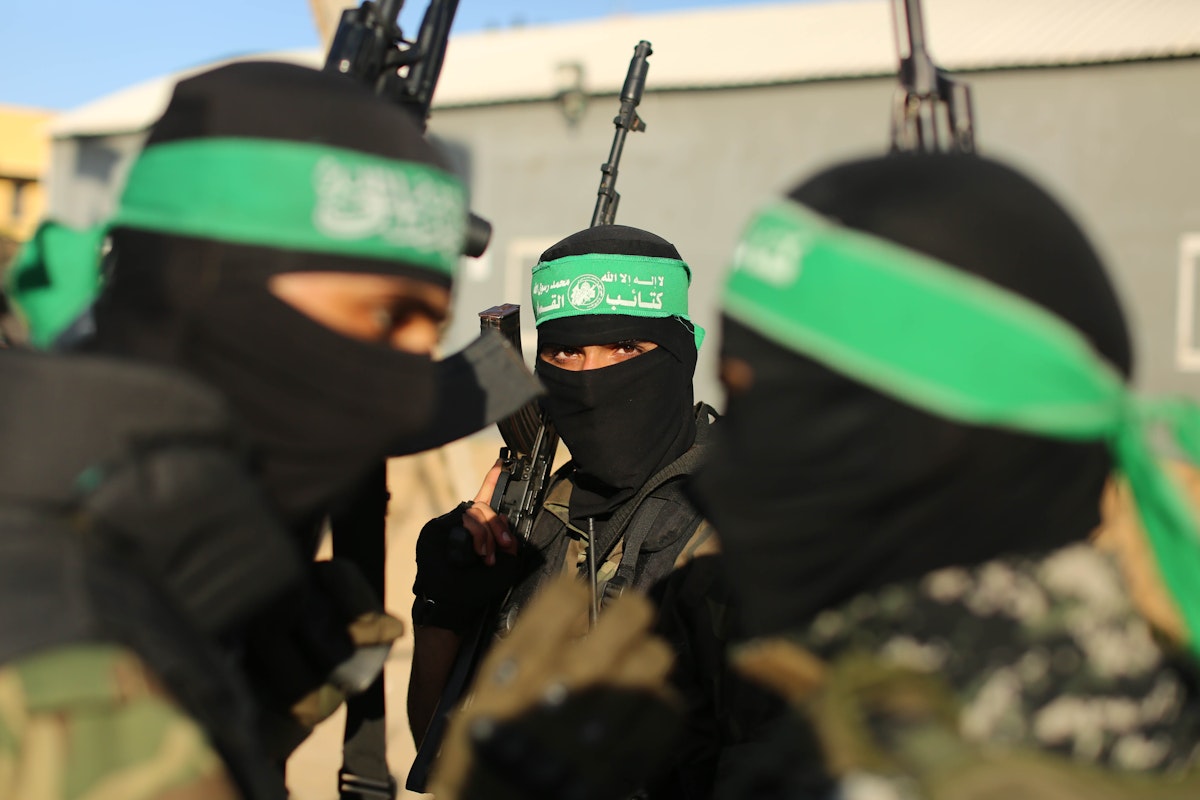Hamas Will Survive Israel’s Invasion of Gaza
Israeli Prime Minister Benjamin Netanyahu recently said Israel is “in the midst of a fight for our existence” and that its invasion of the Gaza Strip aims “to eliminate Hamas by destroying its military and governance capabilities.”That’s certainly a lofty goal. Unfortunately, the American experience in Afghanistan over the past two decades indicates that it is almost impossible to crush a nonstate actor if its leadership and finances are protected in countries that one’s military will not, or cannot, attack. Since Hamas’s leadership lives and its fundraising occurs outside of Gaza, it’s unclear how Israel can truly fulfill its goal of destroying the terrorist group. One of this conflict’s greatest ironies is that Hamas has Netanyahu to thank in part for its strength. For years, he has propped up Hamas in Gaza in order to weaken the Fatah-led Palestinian Authority, or P.A., in the West Bank, thereby dashing hopes for a two-state solution. He reportedly admitted as much in 2019, in defending his decision to allow Qatari funds to flow into Gaza.Another irony is that while Hamas fully controls the institutions of governance in Gaza, the P.A. is paying the lion’s share of the international aid flowing into the area. For example, in 2021 alone, the P.A. transferred $1.7 billion to Gaza, theoretically to pay the salaries and pensions of tens of thousands of civil servants idled by Hamas’s brutal takeover of Gaza in 2007. A similar phenomenon occurred in Iraq when Baghdad for years effectively subsidized tens of thousands of workers operating in Islamic State–controlled areas.The P.A.—which Secretary of State Antony Blinken recently said should take over Gaza once the war is over—reportedly transfers up to 30 percent of its annual budget to the Gaza Strip. The authority also controversially pays a stipend to Palestinians in Gaza and elsewhere who are imprisoned in Israeli jails, or to the families of Palestinians who were killed while carrying out an attack. But here’s a further conundrum: Israel collects the P.A.’s taxes and customs duties—which make up 65 percent of the Palestinian budget—because the P.A. does not have official statehood status. This means Israel can freeze or deduct this money whenever it likes, which it did earlier this month.Additional aid to Gaza comes from oil-rich Qatar (where many senior Hamas leaders live and work in luxurious surroundings), which in 2021 provided $360 million for Hamas government salaries and cash handouts to families—with Israel’s knowledge and approval. The United Nations funds and runs schools and hospitals in Gaza and employs many workers, teachers, and medical personnel, spending $600 million in 2020. These are, of course, avenues for Hamas to extract money through taxes, extortion, and black marketeering, despite the efforts of international overseers, including Israel itself. All this is to say that every dollar—or shekel, as the P.A. and Hamas largely pay their employees in Israeli currency—that Hamas does not have to spend on Gaza schools, hospitals, government salaries, and governance, the group can instead spend on terrorist purposes. Hamas imposes taxes and fees on the local population; that money is then spent on Hamas’s end goals. It is unclear how much of the P.A. money is skimmed by Hamas, but if the Islamic State’s financial management structure in Mosul can serve as a rough guide, it could be up to 50 percent. This is in addition to what other donors provide. Anonymous Western officials speaking to The Wall Street Journal estimated that Iran provides Hamas $100 million annually for military activities, while the terrorist group generates $12 million to $15 million a month on smuggled Egyptian goods, according to Gaza-based economist Mohammed Abu Jayab. A recent analysis from Die Welt suggests Hamas sits upon a financial empire worth $700 million.Hamas has even experimented in recent years with using cryptocurrencies to evade government surveillance. While the full extent of its efforts is unknown, Israel as recently as mid-October continues to freeze Hamas-linked crypto accounts.Even with these diversified income streams, the money itself never has to touch Gaza. Hamas and its allies, like most sophisticated terrorist groups, have built a complicated web of global money-laundering streams with the assistance of the Iranians. It is probably impossible for forensic accountants to unravel completely Hamas’s financial dealings. The U.S. Treasury Department is playing financial whack-a-mole; last month, it sanctioned several Hamas investment portfolio managers living in the West Bank, Sudan, Turkey, Algeria, and Qatar. A further wrinkle is that if, say, Israel cuts off the P.A.’s $1.7 billion to Gaza, it will negatively impact the very people who would serve as the governing backbone of a potential post-Hamas Gaza. It also doesn’t really cost that much to carry out a terrorist attack. The September 11, 2001, attacks cost Al Qaeda under half a million dollars

Israeli Prime Minister Benjamin Netanyahu recently said Israel is “in the midst of a fight for our existence” and that its invasion of the Gaza Strip aims “to eliminate Hamas by destroying its military and governance capabilities.”
That’s certainly a lofty goal. Unfortunately, the American experience in Afghanistan over the past two decades indicates that it is almost impossible to crush a nonstate actor if its leadership and finances are protected in countries that one’s military will not, or cannot, attack. Since Hamas’s leadership lives and its fundraising occurs outside of Gaza, it’s unclear how Israel can truly fulfill its goal of destroying the terrorist group.
One of this conflict’s greatest ironies is that Hamas has Netanyahu to thank in part for its strength. For years, he has propped up Hamas in Gaza in order to weaken the Fatah-led Palestinian Authority, or P.A., in the West Bank, thereby dashing hopes for a two-state solution. He reportedly admitted as much in 2019, in defending his decision to allow Qatari funds to flow into Gaza.
Another irony is that while Hamas fully controls the institutions of governance in Gaza, the P.A. is paying the lion’s share of the international aid flowing into the area. For example, in 2021 alone, the P.A. transferred $1.7 billion to Gaza, theoretically to pay the salaries and pensions of tens of thousands of civil servants idled by Hamas’s brutal takeover of Gaza in 2007. A similar phenomenon occurred in Iraq when Baghdad for years effectively subsidized tens of thousands of workers operating in Islamic State–controlled areas.
The P.A.—which Secretary of State Antony Blinken recently said should take over Gaza once the war is over—reportedly transfers up to 30 percent of its annual budget to the Gaza Strip. The authority also controversially pays a stipend to Palestinians in Gaza and elsewhere who are imprisoned in Israeli jails, or to the families of Palestinians who were killed while carrying out an attack. But here’s a further conundrum: Israel collects the P.A.’s taxes and customs duties—which make up 65 percent of the Palestinian budget—because the P.A. does not have official statehood status. This means Israel can freeze or deduct this money whenever it likes, which it did earlier this month.
Additional aid to Gaza comes from oil-rich Qatar (where many senior Hamas leaders live and work in luxurious surroundings), which in 2021 provided $360 million for Hamas government salaries and cash handouts to families—with Israel’s knowledge and approval. The United Nations funds and runs schools and hospitals in Gaza and employs many workers, teachers, and medical personnel, spending $600 million in 2020. These are, of course, avenues for Hamas to extract money through taxes, extortion, and black marketeering, despite the efforts of international overseers, including Israel itself.
All this is to say that every dollar—or shekel, as the P.A. and Hamas largely pay their employees in Israeli currency—that Hamas does not have to spend on Gaza schools, hospitals, government salaries, and governance, the group can instead spend on terrorist purposes. Hamas imposes taxes and fees on the local population; that money is then spent on Hamas’s end goals. It is unclear how much of the P.A. money is skimmed by Hamas, but if the Islamic State’s financial management structure in Mosul can serve as a rough guide, it could be up to 50 percent.
This is in addition to what other donors provide. Anonymous Western officials speaking to The Wall Street Journal estimated that Iran provides Hamas $100 million annually for military activities, while the terrorist group generates $12 million to $15 million a month on smuggled Egyptian goods, according to Gaza-based economist Mohammed Abu Jayab. A recent analysis from Die Welt suggests Hamas sits upon a financial empire worth $700 million.
Hamas has even experimented in recent years with using cryptocurrencies to evade government surveillance. While the full extent of its efforts is unknown, Israel as recently as mid-October continues to freeze Hamas-linked crypto accounts.
Even with these diversified income streams, the money itself never has to touch Gaza. Hamas and its allies, like most sophisticated terrorist groups, have built a complicated web of global money-laundering streams with the assistance of the Iranians. It is probably impossible for forensic accountants to unravel completely Hamas’s financial dealings. The U.S. Treasury Department is playing financial whack-a-mole; last month, it sanctioned several Hamas investment portfolio managers living in the West Bank, Sudan, Turkey, Algeria, and Qatar. A further wrinkle is that if, say, Israel cuts off the P.A.’s $1.7 billion to Gaza, it will negatively impact the very people who would serve as the governing backbone of a potential post-Hamas Gaza.
It also doesn’t really cost that much to carry out a terrorist attack. The September 11, 2001, attacks cost Al Qaeda under half a million dollars, according to the 9/11 Commission—with the hijackers even returning $26,000 to an Emirati facilitator right before the strike because they didn’t need it. While it remains unclear how much it cost Hamas financially for its October 7 attack on Israel, the terrorist group almost certainly has enough flexibility to weather whatever financial penalties are coming. And if not, their funders have more than enough money to compensate them for their losses.
Terrorism is political theater; the terrorists want the public to watch their horrific acts and to fear what’s coming next. That’s likely why so many Hamas attackers wore GoPro cameras and videotaped their murderous behavior. But their monstrous activities were in service of a political goal—to force an overreaction by Israel that causes misery for a civilian population where Hamas hides and operates. This can generate new recruits, propaganda, and support—diplomatic and financial—from allies in the region and further abroad.
Hamas must be destroyed or at least neutered as a terrorist organization for this conflict to conclude. Sadly, without eliminating Hamas’s leadership outside of Gaza and cutting off its regional financial lifelines, the goal of decisively crushing the group once and for all will remain out of reach. After this round of war ends, there will remain aggrieved Gazans looking to commit violence against Israel, buttressed by an Islamist ideology to justify murderous actions. There will also continue to be enough money and direction from outside of the Strip. Thus, the conflict in Gaza will likely burn on, ebbing and flowing as it has done for years, no matter the outcome of Israel’s current military operation.



